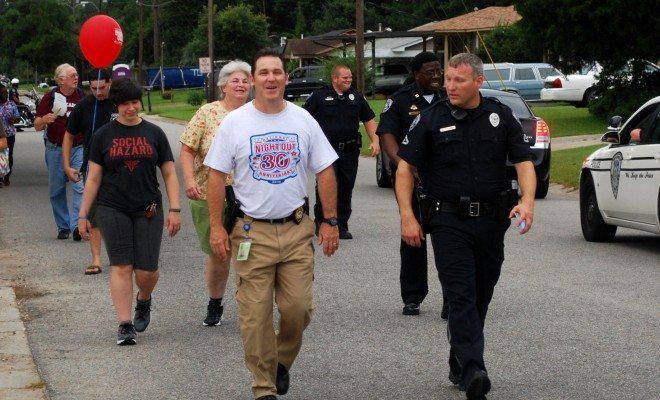
Crime
Community Policing in New Jersey: A Model for Stopping Local Violence
Paterson, New Jersey erupted last month after a 12-year-old girl was shot and killed. People rallied for an end to the recent violence, demanding a safer city in the wake of Genesis Rincon’s death. The tragedy comes shortly after Jerry Speziale was appointed as the new police director. Advocating community policing, Speziale and Mayor Jose Torres think that dynamic approaches can help with the crime problem in Paterson. This may seem like a interesting new strategy for fighting local crime and violence, but successful community policing programs were successfully used in Paterson not that long ago.
One such community policing program, the Village Initiative, operated from 1998 to around 2010 and had some measurable benefits for local youth. What did the Village Initiative accomplish, can community policing prevent further deaths like Rincon’s, and what can other cities learn from Paterson?
Paterson has long been plagued by high crime rates. The year that the Village Initiative launched, its violent crime rate per 100,000 inhabitants was roughly 67 percent higher than the national average. The Village Initiative responded to the crime problem in Paterson by bringing the community to at-risk juvenile probationers, making them responsible for their court orders, and reducing their chances of committing a crime again.
In an interview, Dr. James Pruden said that it’s important “for [juveniles] to see the government functioning positively in their lives.” An emergency medical specialist at St. Joseph’s Regional Medical Center in Paterson, Pruden was an active contributor to the Village Initiative who rode along with officers to visit at-risk probationers. Along with police, teachers, and other community leaders, he saw the program in action and witnessed its effects firsthand.
The Village Initiative
The Village Initiative offered important opportunities to minors such as vocational courses; from business training to cosmetology and automotive repair, the courses gave them opportunities to build marketable skills. In addition, there were components that set juveniles up for part-time jobs. These are no longer available, though. Around 2010, the Village Initiative lost much of its funding, likely related to the city’s other budget cuts during the midst of the national recession. Fortunately, the “ride along with a medical evaluation” that Pruden participated in continued after the funding stopped, along with a few other pieces of the program.
“They had this educational piece, they had the medical piece, they had the business piece, all designed to turn these kids in a different direction and to show them that the interest in them was not only because they were misbehaving,” said Pruden. The community was not simply responding to the negativity surrounding the juveniles’ lives, it was about instilling something positive in them. This should be the central tenant of all community policing initiatives.
“It’s not like I’m providing much of a medical service. What I would do was go to the house, find out what was going on, talk to them about their health issues… At the end of it, I would go back with the data the next day and talk to a case manager at the hospital. She would call them up and make sure they made their cardiology appointment, or she would cut through the red tape to facilitate their entry to the teen pregnancy program. And we would do this not only for patients that came to our hospital, we do this for people who go to free-standing clinics or to other hospitals.”
– Dr. James Pruden
The Results
St. Joseph’s Hospital sometimes treats rival gang members simultaneously, and the hospital could become a spot for continued dispute between them. As that conflict can be detrimental to the doctors and families there, Pruden was tasked with making the hospital a neutral zone. Through the social infrastructure of the Village Initiative, he reached out to community leaders to establish correspondence and set up meetings with gang members. After eight months of work,Pruden succeeded in negotiating with the gangs so that St. Joseph’s would be a safer space.
Anecdotes like that help illustrate the positive community relationships formed by the Village Initiative. But what do statistics tell us about its effects? Despite sharing some criticism about how data on the program was collected, Dr. Pruden said that the available information shows impressive results. Prior to the Village initiative, juveniles with first-time probation had a 37 percent recidivism rate; however, kids involved in the Village Initiative had recidivism rates of only 5 percent. But, he reminded me, “then the funding went away!”
As Pruden says, maybe the effects of the Village Initiative could be judged solely by the difference between a 37 percent and five percent recidivism rate. Maybe it could have only made changes in the lives of the specific juveniles who were involved in the program. But it could also be judged by the potential, immeasurable impact that ripples throughout the community, starting with those juveniles.
Lessons from the Village Initiative
From local advocates to national movements, community policing is in high demand now. For instance, more cops are patrolling neighborhoods on bicycles as a part of a community policing initiative in Lowell, Massachusetts. Nationally, the Obama Administration has ramped up the Community Oriented Policing Services (COPS) office under the Department of Justice. A COPS report, Community Policing Defined, states that the approach “promotes organizational strategies, which support the systematic use of partnerships and problem-solving techniques.”
However, COPS is sometimes criticized for pushing policing in the opposite direction; reporter and author Radley Balko said that COPS supports many police chiefs who consider SWAT raids “to be a core part of a community policing strategy.” As police aggression only divides the police and the community, there is even more need to prescribe the Village Initiative. If Balko is correct and many have misconceptions, the country should find a model for community policing in the success of Paterson’s project.
Pruden’s work through the Village Initiative was not just a medical house call, but a social checkup. This should be how community policing looks, with community leaders working with one another. Police supervise medical evaluations, doctors help police at-risk youth, and the force of the community creates something positive together. Let’s prescribe the Village Initiative’s community policing in New Jersey to other cities in need.
—
Jake Ephros (@JakeEphros)
Featured image courtesy of [City of North Charleston via Flickr]








Comments